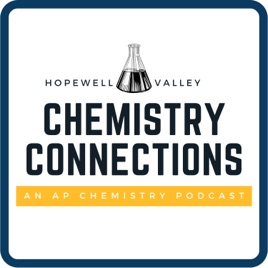
Advertise on podcast: Chemistry Connections
Country
This podcast has
57 episodes
Language
Explicit
No
Date created
2021/09/21
Average duration
11 min.
Release period
0 days
Description
The Chemistry Connections Podcast is a student-run podcast that examines the chemistry behind real-world topics that interest Mr. Johnson's AP Chemistry students. Students talk about an array of topics such as food, art, history, medicine, and much much more.
Podcast episodes
Check latest episodes from Chemistry Connections podcast
Chemistry of Rockets
2023/07/05
Hopewell Valley Student Podcasting NetworkChemistry ConnectionsChemistry of Rockets and Space CraftsEpisode #15 Welcome to Chemistry Connections, my name is Vanessa and I am your host for episode #15 called Chemistry of Rockets and Space crafts. Today I will be discussing how rockets are launched into space and how people are able to survive in the vessels. Specifically, how chemistry helps make space travel possible.
Segment 1: Introduction to Rockets and Space CraftsWhat is a rocket?
First off I’m going to talk about what a rocket actually is. Usually when you think of a rocket, you probably think of a tall, thin, round vehicle. However, a rocket isn’t just the traditional spacecraft but it can also be the engine and any vehicle that uses the engine
When were rockets invented?
The first “rockets” were created in China in the 1200s. They used solid fuel and were used as fireworks. They were also used by armies. Overtime, rockets evolved and became bigger. Rocket production really picked up during the cold war, where in 1957 the Soviet’s Sputnik was launched. In 1969, the United States sent the first men to the moon with the Saturn V rocketHow rockets and spacecraft work have changed over time, especially with the types of engines used and how the engines work.
Shuttles and space capsules (apollo missions)
How do the engines work?
The engines burn fuel, which turns into hot gas which is then pushed out the back by the engine. The gas causes the rocket to propel upwards and move forwardsA rocket engine is different from a jet engine because it doesn't need air. It has everything it needs, allowing it to work in space.There are two types of engines:Liquid fuels (used in the space shuttles and Russian Soyuz)First liquid fuel rocket which is used today was invented by Robert H GoddardSolid fuels (on the side of the space shuttles)
Rockets/Space Crafts Today:
ISS (International Space Station)NASA, Russia’s Roscosmos, Japan’s JAXA, Europe’s ESA, and Canada’s CSATo conduct research and study spaceArtemis missionsReturn to the moon, long term presence on the moon, to study and better understand the lunar...
more
Chemistry of Cosmetics
2023/07/05
Hopewell Valley Student Podcasting NetworkChemistry ConnectionsChemistry of CosmeticsEpisode #14Welcome to Chemistry Connections, my name is Sydney Yeh and my name is Hannah Chu and we are your hosts for episode 12 called Chemistry of Cosmetics. Today we will be discussing the chemistry of cosmetics.
Segment 1: Introduction to CosmeticsWhat are cosmetics?
(General cosmetics)
There are thousands of different cosmetic products on the market, all with different combinations of ingredients. In the United States alone, there are approximately 12,500 unique chemical ingredients approved for use in personal care products. A typical product could contain anything from 15–50 ingredients. Considering the average woman uses between 9 and 15 personal care products per day, researchers have estimated that, when combined with the addition of perfumes, women place around 515 individual chemicals on their skin each day through cosmetic use.
(History of cosmetics)
Let’s take it back to cosmetics in the olden times. Cosmetics were first seen in ancient Egypt, where makeup served as a marker of wealth believed to appeal to the gods. The elaborate eyeliner characteristic of Egyptian art appeared on men and women as early as 4000 BCE. Kohl, rouge, white powders to lighten skin tone, and malachite eye shadow (the green color that represented the gods Horus and Re) were all in popular use. By 3000 B.C men and women in China had begun to stain their fingernails with colors according to their social class, while Greek women used poisonous lead carbonate to achieve a pale complexion.
Segment 2: The Chemistry Behind Cosmetics(pigments/color)
A huge range of substances are used to create many appealing colors found in makeup. Mineral ingredients include iron oxide, mica flakes, manganese, chromium oxide, and coal tar. Natural colors can come from plants, such as beet powder.
Cosmetic pigments are broken up into two types, organic and inorganic.
Inorganic pigments consist of iron oxides, chromium dioxides, ultramarines, manganese violet, white pigments, and pearlescent effects. They are used for their opaque color coverage, making them particularly suitable in face and eye makeup. They are usually duller in appearance than organic pigments. The transition metals in inorganic pigments form colorful ions, complexes, and compounds. This is due to the unfilled d orbitals these elements have. When transition metal ions form complexes and...
more
Chemistry of Alchemy
2023/07/05
Hopewell Valley Student Podcasting NetworkChemistry ConnectionsThe Chemistry of AlchemyEpisode #13Welcome to Chemistry Connections, my name is Cameron Scott/Anish Ponnam and we are your hosts for episode #19, The Chemistry of Alchemy. Today we will be discussing the chemical origins of one of the most famous myths of all time.
Segment 1: Introduction to AlchemyWhat is the legend of the alchemists?:
- The history of the word alchemy comes from 332 BC when Alexander the Great conquered Egypt and this led Greek concepts of Fire, Earth, Air, and Water to merge with the Egyptian science of the time. This merging of ideologies led way to concept of Khemia, which was the Greek word for Egypt. Finally, when the Arabs occupied Egypt in the 7th century, they decided to add the prefix “al-” to the word “Khemia” and this led to Alkhemia being made and is now believed to be the origin of the word Alchemy.
- Although alchemy was thought to be originated in Egypt, China also developed their own method of alchemy through the use of minerals and plants which was thought to prolong life and also the use of exercise techniques, such as Qigong, to manipulate the chi or life force of the body.
- India also developed their own version of alchemy which was very similar to that of China’s in which they wanted to use it to prolong life by purifying the body. Due to their curiosity with Alchemy, the indians were able to invent steel which is used in everyday construction as the framework of buildings.
Segment 2: The Chemistry Behind AlchemyWhen lead acetate and potassium iodide are mixed in solution, a precipitate of lead iodide is formed.
Explain how lead acetate was available during the alchemy times
Produced by first burning elemental lead (creating lead oxide), then boiling it in acetic acid. In other words, vinegar.It has been documented that the romans used lead acetate as a sweetner, and the remains of those who lived during that time period, even Pope Clement II, have been found to indicate death by lead acetate poisoning.
Explain how Potassium iodide was available in the alchemy times
KI has a high natural source in kelp, which draws in high concentrations of iodine from seawater during its photosynthesis process.KI can be extracted from seaweed by singeing it down to ash, then filtering the ash with distilled water to separate it from charcoal particlesMediterranean societies have been documented using seaweed for food and medical productionIt is plausible that an alchemist was able to derive KI from seaweed
span...
more
Chemistry of Film Cameras
2023/07/05
Hopewell Valley Student Podcasting NetworkChemistry ConnectionsThe Chemistry Behind Film CamerasEpisode #12 Welcome to Chemistry Connections, our names are Riya Mishra and Summer Wang and we are your hosts for episode #12 called the Chemistry Behind Film Development. Today we will be discussing what makes film cameras, such as Polaroids, or Canon Cameras, work.
Segment 1: Introduction to Film CamerasIn this episode, we’re going to be talking about how film is developed, and the chemical processes which occur every step of the way. Thanks to inventor and scientist Edwin H. Land, people can enjoy the look of a film picture without having to go through the process of developing film. Picture dark room photography, the low lights, the chemicals, and the long-long process before you get your photos. Now imagine that condensed into a tiny camera, weeks of work can be completed in a minute. This popular camera, made by popular companies like Polaroid and Instax provides a physical, and tangible memento in an instant. It seems like magic… but it’s all chemistry.
Segment 2: The Chemistry Behind Film Cameras
When you hit ‘click’ on your camera, how does the photographic film develop on an atomic level? Firstly, it’s important to know that film is covered in a crystalline solid, usually a silver halide (so silver and a halogen). The most popular choice for film is silver bromide (AgBr). When photons from light come into contact with one of the grains, an electron is ejected from the valence levels of the bromine atoms, and onto the conduction band of the crystal. Then, the electron combines with a moving silver ion, and makes atomic silver. When this occurs multiple times, a clump of silver metal is produced. That atomic silver creates dark areas on the paper due to its color. The colorless ion Ag+ gains an electron to form solid silver. This seemingly simple reaction creates the dark colors that you see in your pictures. The formation of silver metal is directly proportional to the intensity of light. This may sound confusing, but it means that more light hitting the film means that area will appear darker when the film is developed. So, if anyone ever tells you to keep your picture in the dark as it develops, you know why.
For non-instant film cameras, once the picture is taken, film must be placed in a developer, or a chemical liquid which makes the concealed image on the film eventually visible. Developer itself can be chemically altered to adjust the rate at which the film develops-mainly with the usage of developing agents. Without developing agents, the process of film development could take hours, or even days! But, with some developing agents, like potassium hydroxide (KOH), this process can be sped up. You see, for film to develop at the quickest rate possible, the developing solution should have a pH between 10-11. This is a pretty high pH, meaning there needs to be a way for film developers to reach that pH without interfering with other parts of the developing process. KOH happens to be an extremely strong alkali, or a strong base. When KOH is added to the film, it produces an alkaline solution on top of the film. This raises the pH, bringing it...
more
Chemistry of Northern Lights
2023/07/05
Hopewell Valley Student Podcasting NetworkChemistry ConnectionsChemistry of the Northern LightsEpisode #11 Welcome to Chemistry Connections, my name is Ben Pollara and my name is Megan Meng and we are your host for episode #11 called The Chemistry of the Northern Lights. Today we will be discussing why the Northern Lights occur and the chemistry behind it.
Segment 1: Introduction to Northern LightsFor our segment we will be discussing the Northern lights. Scientifically referred to as Aurora Borealis, the Northern Lights are a natural light phenomenon that appear across Earth's great sky. Auroras display dynamic patterns of brilliant lights that appear as curtains, rays, spirals, or dynamic flickers covering the entire sky.
There are many myths behind the aurora borealis. The Eksimo tribes believed that they could summon the aurora to speak with their dead relatives. Inuit tribes feared the lights and carried knives to protect themselves against the aurora. But one thing is for sure now, all the myths behind the lights are FALSE. The science behind the Aurora Borealis is the TRUTH.
We will cover the origins of solar wind which send charged particles towards the earth. Then we will explain how those charged particles create collisions in our atmosphere that lead to the Northern Lights phenomenon.
Segment 2: The Chemistry Behind Northern LightsAlthough the Northern Lights seem too gigantic to comprehend, breaking each process down makes the Northern Lights seem more simple. There are charged particles, collisions, electron excitations, and light waves that all go into the creation of the beautiful Northern Lights.
What is going on on the Sun?The Sun is made up of helium and hydrogen.The origin of solar reactions:
-Inside the sun, reactions are always happening. These reactions are called proton-proton fusion!!
Originating in the core of the sun, a lone hydrogen atom fuses with another hydrogen atom. These two protons usually break apart, but sometimes the hydrogen atoms stay fused. Once fused, a single proton transforms into a neutron because of its weaker nuclear force. A third proton then fuses with the proton-neutron pair, creating a helium atom and releasing gamma rays, or sunlight. Finally, two helium atoms collide, which causes two protons to be released and a heavier isotope of Helium.
The two protons then travel towards Earth’s atmosphere, colliding with atoms such as Oxygen and Nitrogen that make up Earth’s upper atmosphere.
. What are solar winds?Storms on the sun cause solar windsspan...
more
Chemistry of Breaking Bad
2023/07/05
Hopewell Valley Student Podcasting NetworkChemistry ConnectionsChemistry of Breaking BadEpisode #10 Welcome to Chemistry Connections, our names are Nathan and Lucas and we are your hosts for episode #10 called The Chemistry of breaking bad. Today we will be discussing how Mr Walter White creates his signature blue meth.
Segment 1: Introduction to Breaking BadIn Breaking Bad there are many episodes where chemistry is incorporated into the show; I mean Walter himself is a chemistry teacher, but nevertheless, chemistry is what makes Breaking Bad, Breaking Bad. In this episode we are going to break down one of the most iconic propsin the show: the infamous blue crystals Walter cooks up
Breaking Bad is a popular tv show, in which the main character, Walter White, a High School Chemistry teacher, starts creating drugs and selling them to make cash after he is informed that he has cancer.
We are going to focus on how blue meth, methylamphetamine, is made and the psychological effects it has. Basically, this is a step-by-step guide on how to make meth. Jk jk, this is just a step-by-step guide, speculating how meth was made in the show
Segment 2: The Chemistry Behind Blue MethThroughout the story, two different methods of synthesis are used:
The first method Walter uses is pseudoephedrine, little Sud. Walter obtains little sud from the over-the-counter drug Sudafed
By combining red phosphorus—gathered from matchbox strike strips—and iodine, a person can create a strong acid removing the little cluster of hydrogen and oxygen that separates Sudafed from meth. Little suds molecular formula is C10H15NO, while the molecular formula of meth is C10H15N. So as you can see the molecular formula between these two are very close.
Reference connection to bondingThis relates to bonding because Methamphetamine, as well as pseudoephedrine, contains carbon (C), hydrogen (H), nitrogen (N), and oxygen (O) atoms, which are elements commonly involved in covalent bonding.Reduction is part of this reaction.We are familiar with reduction from Redox reactionsReduction is a chemical reaction that involves the gaining of electrons by one of the atoms involved in the reaction between two chemicals.The pseudophedrine substance undergoes reduction and turns into N-methamphetamine..
The second method Walter uses is a synthesis method from Phenylacetone aka P2P.P2P has a similar shape to methamphetamine and Sudafed. It has a circular...
more
Chemistry of Wine Production
2023/07/05
Hopewell Valley Student Podcasting NetworkChemistry ConnectionsThe Chemistry of WineEpisode #9 Welcome to Chemistry Connections, our names are Erin Goldsmith and Gianluca Procaccini, and we are your hosts for episode 9 of Chemistry Connections. Today we will be discussing the chemistry of red wine.
Segment 1: Introduction to Red Wine ProductionIn this episode, we will be covering the chemistry of red wine production. We will mainly be discussing the fermentation process that turns the grapes into wine, after the harvesting process, prior to bottling the wine.
To start, we’ll define some key terms:
Ethanol is the form of alcohol that is in wine. Typically in a range anywhere between 7-15 percent.
Tannic acid aka tannins are a naturally occurring molecule which cause a dry feeling in your mouth and are bitter when ingested. Tannins can be extracted from skins, seeds, bark, and plant stems.
Tartaric acid is the one of the components in wine that controls the overall acidity. Too much can cause an overly tart, sharp wine; while too little can cause a wine that is flat and bland.
Sulfites are the component of wine that act as a preservative and an agent that halts the fermentation process which can help protect the wine against potential oxidation or bacterial exposure which could occur at various stages of the winemaking process.
Malic acid is another acid found in grapes that is primarily responsible for sour flavors, its concentration decreases as a grape ripens.
Also, we’ll discuss the origins of wine. Wine was first created in Georgia in 6000 BCE by accident. When stored grapes ended up getting fermented by naturally occuring yeast. After this, yeast became domesticated and spread throughout the Caucuses and then moved into Europe.
Segment 2: Personal ConnectionsErin was interested in researching the chemistry of wine after watching Star Trek Picard. In the first season, Captain Jean-Luc Picard has retired to the French countryside, and now makes wine. The quality of Picard’s wine becomes a running joke in later seasons.
Gianluca is interested in researching winemaking because of the 100 Days winemaking simulator video game.
Wine production is an important part of many lives. The wine industry spans multiple countries,...
more
Chemistry of Soda
2023/07/05
Hopewell Valley Student Podcasting NetworkChemistry ConnectionsChemistry of SodaEpisode #8 Welcome to Chemistry Connections, my name is Neha and Nikhil and we are your hosts for episode #8 called Chemistry of Soda. Today we will be discussing basically that: the chemistry involved in soda.
Segment 1: Introduction to SodaSoda is a fizzy beverage that people love to drink, ourselves includedThere are many different kinds of soda. To name a couple: CokeFantaRoot beerPepsi And moreYou can find it at any local grocery storeIt is an enjoyable drink due to its carbonation and the sting it has on your tongue, which we will go into depth about shortly
Segment 2: The Chemistry Behind SodaTopic 1: Equilibrium
First, let’s talk about the fizz in sodaCitric acid reacts with the carbonate in bicarbonate of soda to form carbon dioxide gas These bubbles of carbon dioxide gas are what make your drink fizzyThese molecules of carbon dioxide are thoroughly mixed and dissolved into the water in the soda popThis is known as carbonationRegarding carbonation, it is important to note: Carbon dioxide doesn’t easily dissolve in water under everyday conditionsManufacturers have to increase the pressure in the can and keep it at a low temperature so water molecules can trap lots of carbon dioxide moleculesThey also use pressure to put more gas in water than it could normally hold at that temperatureTherefore, if the soda can warms up a bit or the can is shaken, pressure goes up and extra gas is ready to come upSo opening the can releases pressure, and soda shoots outThis is why the can is sealed so that it is airtight. That way, the inside of the can maintains enough pressure to prevent extra carbon dioxide molecules from escapingspan...
more
Quantum Chemistry
2023/07/05
Hopewell Valley Student Podcasting NetworkChemistry ConnectionsQuantum ChemistryEpisode #7 Welcome to Chemistry Connections, my name is Owen Mahan and I am your host for episode #7 called Quantum Chemistry. Today I will be discussing how the effects of quantum mechanics lead to chemistry.
Segment 1: Introduction to Quantum MechanicsQuantum mechanics is the mechanism behind the world on the smallest scaleQM acts on the smallest scale, classical mechanics on our scale, relativity on a large scaleQuantum comes from the fact that things are quantizedEnergy, charge, etc can only have certain integer multiples of quantitiesSchrodinger equation (or the wave function) means the values of quantum systems are only probabilisticHeisenberg uncertainty principle means you can’t know everything about a systemPauli exclusion principle says that multiple of the same fermion can’t exist at the same timeFermions have ½ integer spin (electrons, quarks, nucleons by extension, etc) while bosons have whole integer spin (photons, gluons, etc)
Segment 2: Quantum Effects on ChemistryBonding/Potential EnergyAll chemical interactions are based on quantum mechanicsBonding occurs because of low potential energy states and electron clouds form because of thatMetallic bonding was used to discover QM via photoelectric effect (Einstein)A solution to the schrodinger equation using Born-Oppenheimer methods is what gives the energy vs nuclear distance graph (as seen on the AP exam)Overlapping is the process by which electron clouds enter a newly favorable state as atoms bondResonance structures are superpositions of electrons within molecules which create multiple simultaneous overlapping cloud structuresOrbitals occur because of spin mechanics as ½ spin particles cannot be indistinguishable, so a max of two electrons (½ and -½ spin respectively) can occupy an orbitalHelium superfluid occurs because He-4 atoms have 0 combined spin so can fall into the same statesNeutron stars (the densest things in the universe) occur because the pressure of fermions not wanting to occupy the same state barely...
more
Chemistry of Venomous Snakes
2023/07/05
Hopewell Valley Student Podcasting NetworkChemistry ConnectionsChemistry of Snake VenomEpisode # 6 Segment 1: Introduction to Snake Venoms2 Main categories of venomous snakesElapids ElapidsAny of 300 species of venomous snakes (all venomous)Short, fixed fangs at the front of the JawLong, slender bodies with small headsMostly lay eggs, but a few do bear living young (largely only Australian species)Bite with a downward strike, and often chew prey to envenomateBite relatively painless, but can kill quickly through paralysis of heart and lung musclesCobra relativesTalk about fang structureGeneral characteristicsViperids (Vipers)Over 200 related speciesLong, hollow fangs that are folded back to the roof of the mouth until strikingSome species, known as pit vipers, have a temperature-sensing organ that allows them to hunt warm-blooded prey even when they cannot seeLarge venom glands lead to a more triangular or pear-shaped head Fang structure and general characteristics
Segment 2: The Chemistry Behind Snake VenomsHave a natural transition into an example… no need to say “segment 2”
Provide detailed explanations of the chemistry that is related to your topic.
Remember that you must have a minimum of 2 topics from ap chem that you can explain here as related to your episode
Viperid and elapid venom mechanism of actionViperid - hemolytic and necroticHow and whySpecific example - Saw-scaled viper (Echis carinatus)Affects blood circulation, causing severe tissue and organ damage.Certain proteins prevent
more
Chemistry of Antacids
2023/07/05
Hopewell Valley Student Podcasting NetworkChemistry ConnectionsChemistry of AntacidsEpisode #5Welcome to Chemistry Connections, our names are Janya and Arya and we are your hosts for episode #5 called The Chemistry of Antacids, which is also what we will be discussing today.
Segment 1: Introduction to AntacidsFor this segment we are going to be talking about what antacids are, and in what situations they can be used for.
Do you know what antacids are?
Not really….
Well, they are medicines used to treat heartburn and indigestion!
But what is heartburn exactly? Is you’re heart on fire?
Noooo. Heartburn is caused by excess stomach acid that travels up the esophagus.
Sounds gross!
Well, if you want to reduce them, you can reduce the amount of acid in your stomach, by eating less acidic foods for example.
Some acidic foods include tomatoes, oranges, and… chocolate. (yes if you want to have less heartburns, you have to eat less chocolate).
Right, so when you eat less of these foods, the acid won’t have a chance to travel up the esophagus. I get it now!
Antacids also do the same thing, because it reduces the amount of acid that’s in your stomach (technically, the excess acid)
And your problem is solved!
But not really, because this didn’t treat the actual cause of heartburns or indigestion
They usually relieve symptoms for a few hours, so it is not a permanent solutionAntacids can be found in liquid form as well as tablet form, but liquid form works better (don’t really need to say)Antacids helps to relieve a variety of symptoms such as a burning sensation/pain in your chest/stomach, acidic taste in your mouth, feeling of being bloated. More serious problems which antacids can help treat include: acid reflux (GERD), stomach lining inflammation (gastritis), and stomach ulcersSome common active ingredients in antacids include aluminum, calcium, magnesium, and salts (sodium).These active ingredients help raise the pH level in the stomach, reducing the acidity and providing temporary relief from symptoms. Antacids typically provide quick but short-term relief and are not intended for long-term use. It's important to follow the instructions provided by the manufacturer or consult a healthcare professional for appropriate usage and dosage recommendations.
span style="background-color:...
more
Chemistry of Cotton Candy Grapes
2023/07/05
Hopewell Valley Student Podcasting NetworkChemistry ConnectionsChemistry of Cotton Candy Grapes Episode # 4Welcome to Chemistry Connections, my name is Olivia, and I am your host for episode 4 called The Chemistry of Cotton Candy Grapes. Today, I will be discussing what acids are within a grape and how cotton candy grapes are made.
Segment 1: Introduction to Cotton Candy GrapesCotton Candy grapes are a variation of green grapes whose flavor is compared to the carnival fluffy, sweet confection cotton candy.
The process of turning a regular grocery store grape into a cotton candy grape is called hybridization. The common belief among people is that grapes are produced by injecting artificial flavoring; however, the cotton candy taste is through plant breeding. Hybridization happens between two different grape species; a type of Concord-like grape (like grapes used in Welch's jams, jellies, and juices) and a variety of Vinis vi nif er uh, an everyday grape found at grocery stores across the country.
A Horticulturist is responsible for this process. Horticulturists are specialists with training in plant production and development who monitor and enhance the growth of high-quality food plants, decorative plants, and medicinal herbs.
These medium-sized, oval, or oblong grapes are seasonal fruit. They are also lacking seeds by default. We'll cover everything that makes people wonder about the odd characteristics of these grapes, including their structure and sugar content.
Segment 2: The Chemistry Behind GrapesFirst, let's discuss what a grape really is. Grapes are made up of 70-80% water and are made up of acids which include tartaric, malic, and citric acid. Green grapes are more acidic (pH: 2.4). Red grapes (5.5-7) can be neutral. Acids contribute to overall acidity, giving a refreshing and tangy taste.
But what is an acid? An acid is created when substances dissolved in water increase the H+ ions in the solution. Donation of protons by acids (bronsted-Lowry) pH: range 0-14. Acids are less than 7 on a pH scale, and this is determined by H+ concentration. They also have different elements, such as their corrosive nature (ex rocks) and ability to conduct electricity (can conduct when dissolved in H2O). The H acts as a proton donor lowering pH. Acid-Base reactions (react with alkaline substances products are salts and water) (neutralization). There 7 strong acids, and these completely dissociate in H2O, while weak acids only partially dissociate (lower concentration of H+)
Grapes have a pH value that ranges from 1.9 to 4, which makes them an acidic fruit. These acids are at their highest concentration when the grapes are unripe, and acid content decreases as they mature. One of the acids in grapes, malic acid, has an ionizable hydrogen on each end of the molecule. This H dissociates and attaches to water molecules, making H3O+ which the tongue then detects as a sour taste.
span...
more
Podcast reviews
Read Chemistry Connections podcast reviews
Podcast sponsorship advertising
Start advertising on Chemistry Connections & sponsor relevant audience podcasts
You may also like these education Podcasts

4.9
5198
148
Trading Secrets
Audioboom Studios

4.8
574
238
The Shit No One Tells You About Writing
Bianca Marais, Carly Watters and CeCe Lyra

4.8
1103
343
Straight A Nursing: Study for nursing school exams and NCLEX
Maureen Osuna, MSN, RN - Nursing school educator, author, and nursing student enthusiast.

4.5
1226
412
Bigfoot Eyewitness Radio
Vic Cundiff

4.5
3073
291
EXPANDED Podcast by To Be Magnetic™
To Be Magnetic™

4.9
578
167
Pantry Chat - Homesteading Family
Homesteading Family

4.8
513
141
Talk To Me In Korean
Talk To Me In Korean

4.8
44
85
The Structural Engineering Podcast
Zach and Max

4.7
495
886
Luke's ENGLISH Podcast - Learn British English with Luke Thompson
Luke Thompson

4.7
170
311
Garden Basics with Farmer Fred
Fred Hoffman



